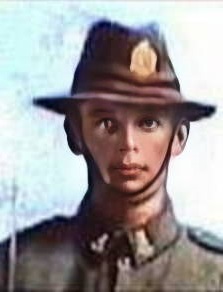Rfn
Ernest Mann
Information about birth
|
Date of birth: 31/03/1893 |
|
Place of birth: Invercargill, Southland, New Zealand |
General information
|
Last known residence: 1 Lowe Street, Avenal, Invercargill, Southland, New Zealand |
|
Profession: Cooper |
|
Religion: Church of England |
Army information
|
Country: New Zealand |
|
Force: New Zealand Expeditionary Force |
|
Rank: Rifleman |
|
Service number: 42682 |
|
Enlistment date: 14/12/1916 |
|
Enlistment place: Balclutha, Clutha, Otago, New Zealand |
|
Units: — New Zealand Rifle Brigade, 2nd Bn. |
Information about death
|
Date of death: 12/10/1917 |
|
Place of death: Wolf Farm, Passchendaele, Belgium |
|
Cause of death: Missing in action |
|
Age: 24 |
Memorial
|
Tyne Cot, New Zealand Apse Panel: 8 |
Distinctions and medals 2
|
British War Medal Medal |
|
Victory Medal Medal |
Points of interest 4
| #1 | Place of birth | ||
| #2 | Last known residence | ||
| #3 | Enlistment place | ||
| #4 | Place of death (approximate) |
My story
Ernest Mann was born on 31 March 1893 in Invercargill on New Zealand's South Island, where he lived with his parents Herbert and Elizabeth Mann. He was working as a cooper when he enlisted in the New Zealand Expeditionary Force on 14 December 1916. He was assigned to the 2nd Battalion of the 3rd New Zealand (Rifle) Brigade, part of the New Zealand Division.
The New Zealand Division was deployed in the Battle of Passchendaele, which had been raging since 31 July 1917. On 12 October 1917, a major attack was planned on the heights of Passchendaele. Passchendaele was the objective of the 3rd Australian Division, while the New Zealanders advanced to the heights north of the village. The logistics were a nightmare due to persistent rain and shelling. Artillery was at half strength as guns were stuck in the mud or short of ammunition. The result was the perfect storm that was the First Battle of Passchendaele.
At 05h25 on 12 October 1917, the attack began and the 2nd Battalion was immediately held up by heavy machine-gun fire. The barely passable paths and roads became clogged with troops. The advance was chaotic and soon the ranks mixed with Scots from the 9th Division who were on their left. On their left flank, the German cemetery near Wallemolen was captured; in the centre, Wolf Farm was taken. Around 8am, they were ordered to dig in. There was no way through and another attack, planned at 3pm, was called off.
The attack went disastrously. New Zealanders and Australians encountered almost intact overlapping machine gun emplacements on the heights near Bellevue and Passchendaele. Almost 850 New Zealanders, about the same number of Australians, 1,800 British and 1,000 Germans were killed. The Allied offensive was deadlocked.
During the fighting on 12 October, Ernest Mann, 24, was killed. He has no known grave and is commemorated on panel 8 of the New Zealand Apse of the Tyne Cot Memorial.
The New Zealand Division was deployed in the Battle of Passchendaele, which had been raging since 31 July 1917. On 12 October 1917, a major attack was planned on the heights of Passchendaele. Passchendaele was the objective of the 3rd Australian Division, while the New Zealanders advanced to the heights north of the village. The logistics were a nightmare due to persistent rain and shelling. Artillery was at half strength as guns were stuck in the mud or short of ammunition. The result was the perfect storm that was the First Battle of Passchendaele.
At 05h25 on 12 October 1917, the attack began and the 2nd Battalion was immediately held up by heavy machine-gun fire. The barely passable paths and roads became clogged with troops. The advance was chaotic and soon the ranks mixed with Scots from the 9th Division who were on their left. On their left flank, the German cemetery near Wallemolen was captured; in the centre, Wolf Farm was taken. Around 8am, they were ordered to dig in. There was no way through and another attack, planned at 3pm, was called off.
The attack went disastrously. New Zealanders and Australians encountered almost intact overlapping machine gun emplacements on the heights near Bellevue and Passchendaele. Almost 850 New Zealanders, about the same number of Australians, 1,800 British and 1,000 Germans were killed. The Allied offensive was deadlocked.
During the fighting on 12 October, Ernest Mann, 24, was killed. He has no known grave and is commemorated on panel 8 of the New Zealand Apse of the Tyne Cot Memorial.
Sources 2
|
Austin w.S., The Official History of the New Zealand Rifle Brigade, 1915-1919, (Uckfield,The Naval&Military Press Ltd, 10 Ridgewood Ind.Park, East Sussex., 2007), 235-247. Sources used |
|
McCarthy, Chris. Passchendaele: the Day-by-Day Account. (Londen: Unicorn Publishing Group, 2018), 131. Sources used |
More information 5
|
Commonwealth War Graves Commission Database https://www.cwgc.org/find-records/find-war-dead/casualty-details/847907 |
|
Namenlijst (In Flanders Fields Museum) https://namenlijst.org/publicsearch/#/person/_id=7550f670-bc40-4406-9cd0-252bc5f49163 |
|
Lives of the First World War (Imperial War Museum) https://livesofthefirstworldwar.iwm.org.uk/lifestory/7179461 |
|
The NZEF Project (UNSW Canberra) https://nzef.adfa.edu.au/showPerson?pid=156633 |
|
Online Cenotaph (Auckland Museum) https://www.aucklandmuseum.com/war-memorial/online-cenotaph/record/C10290 |
